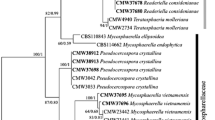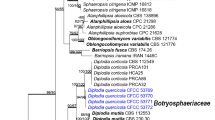Abstract
Species of the Botryosphaeriaceae are important pathogens causing cankers and die-back on many woody plants. In Uruguay, Neofusicoccum eucalyptorum, N. ribis and B. dothidea have previously been associated with stem cankers on plantation-grown Eucalyptus globulus. However, very little is known regarding the occurrence and species diversity of Botryosphaeriaceae in native Myrtaceae forests or what their relationship is to those species infecting Eucalyptus in plantations. The objectives of this study were to identify the Botryosphaeriaceae species present as endophytes or associated with cankers in both introduced and native tree hosts in Uruguay, and to test the pathogenicity of selected isolates obtained from native trees on Eucalyptus. Symptomatic and asymptomatic material was collected countrywide from Eucalyptus plantations and native Myrtaceae trees. Single spore cultures were identified based on conidial morphology and comparisons of DNA sequences of the ITS and EF1-α regions. Six Botryosphaeriaceae species were identified. Botryosphaeria dothidea, N. eucalyptorum and specimens residing in the N. parvum-N. ribis complex were isolated from both introduced Eucalyptus and native Myrtaceae trees, whereas Lasiodiplodia pseudotheobromae was found only on Myrcianthes pungens. Diplodia pseudoseriata sp. nov. and Spencermartinsia uruguayensis sp. nov. are novel species found only on native myrtaceous hosts. Pathogenicity tests showed that isolates obtained from native trees and identified as L. pseudotheobromae, N. eucalyptorum and the N. parvum-N.ribis complex are pathogenic to E. grandis. Interestingly, Lasiodiplodia pseudotheobromae has not previously been found on Eucalyptus in Uruguay and represents a potential threat to this host.







Similar content being viewed by others
References
Alonso R (2004) Estudio de Botryosphaeria spp. en Eucalyptus globulus en Uruguay: endofitismo o patogenicidad? (Studies of Botryosphaeria spp. in Eucalyptus globulus in Uruguay: endophytism or pathogenicity?). Tesis de Maestría en Biología. PEDECIBA, Uruguay, p 52
Alves A, Crous PW, Correia A, Phillips AJL (2008) Morphological and molecular data reveal cryptic speciation in Lasiodiplodia theobromae. Fungal Divers 28:1–13
Balmelli G, Resquin F (2005) Efecto de enfermedades del fuste en Eucalyptus globulus. Revista Forestal 27:9–14
Balmelli G, Marroni V, Altier N, Garcia R (2004) Potencial del mejoramiento genético para el manejo de enfermedades en Eucalyptus globulus. INIA, Serie Técnica, 143
Barber P, Burgués T, Hardy G, Slippers B, Keane P, Wingfield M (2005) Botryosphaeria species from Eucalyptus in Australia are pleoanamorphic, producing Dichomera synanamorphs in culture. Mycol Res 109:1347–1363
Barnard E, Geary T, English J, Gilly S (1987) Basal cankers and coppice failure of Eucalyptus grandis in Florida. Plant Dis 71:358–361
Bettucci L, Alonso R (1997) A comparative study of fungal populations in healthy and symptomatic twigs of Eucalyptus grandis in Uruguay. Mycol Res 101:1060–1064
Bettucci L, Simeto S, Alonso R, Lupo S (2004) Endophytic fungi of twigs and leaves of three native species of Myrtaceae in Uruguay. Sydowia 56:8–23
Brussa CA, Grela IA (2007) Flora arbórea del Uruguay con énfasis en las especies de Rivera y Tacuarembo. COFUSA. Mosca. Montevideo, Uruguay, p 543
Burgess T, Barber P, Hardy G (2005) Botryosphaeria spp. associated with eucalypts in Western Australia, including the description of Fusicoccum macroclavatum sp. nov. Australas Plant Pathol 34:557–567
Burgess TI, Sakalidis ML, Hardy GEStJ (2006) Gene flow of the canker pathogen Botryosphaeria australis between Eucalyptus globulus plantation and native eucalypt forests in Western Australia. Austral Ecology 31:559–566
Coutinho T, Wingfield MJ, Alfenas A, Crous P (1998) Eucalyptus rust: a disease with the potential for serious international implications. Plant Dis 82:819–825
Curlevski NJA, Chambers SM, Anderson IC, Cairney JWG (2009) Identical genotypes of an ericoid mycorrhiza-forming fungus occur in roots of Epacris pulchella (Ericaceae) and Leptospermum polygalifolium (Myrtaceae) in an Australian sclerophyll forest. FEMS Microbiol Ecol 67:411–420
Desprez-Loustau ML, Marcais B, Nageleisen LM, Piou D, Vannini A (2006) Interactive effects of drought and pathogens in forest trees. Ann For Sci 63:597–612
De Wet J, Slippers B, Preisig O, Wingfield BD, Wingfield MJ (2008) Phylogeny of the Botryosphaeriaceae reveals patterns of host association. Mol Phylogenet Evol 46:116–126
Duong LM, Jeewon R, Lumyong S, Hyde KD (2006) DGGE coupled with ribosomal DNA phylogenies reveal uncharacterized fungal phylotypes on living leaves of Magnolia liliifera. Fungal Divers 23:121–138
Farris JS, Kallersjo M, Kluge AG, Bult C (1995) Testing significance of incongruence. Cladistics 10:315–319
Gomez KA, Gomez AA (1984) Statistical procedures for agricultural research, 2nd edn. Wiley Interscience, USA, p 680
Guo LD, Hyde KD, Liew ECY (2000) Identification of endophytic fungi from Livistonia chinensis based on morphology and rDNA sequences. New Phytol 147:617–630
Guo LD, Hyde KD, Liew ECD (2001) Detection and taxonomic placement of endophytic fungi within frond tissues of Livistona chinensis based on rDNA sequences. Mol Phylogenet Evol 20:1–13
Gure A, Slippers B, Stenlid J (2005) Seed-borne Botryosphaeria spp. from native Prunus and Podocarpus trees in Ethiopia, with a description of the anamorph Diplodia rosulata sp. nov. Mycol Res 109:1005–1014
Hillis DM, Bull JJ (1993) An empirical test of bootstrapping as a method for assessing confidence in phylogenetic analysis. Syst Biol 42:142–152
Huang WY, Cai YZ, Hyde KD, Corke H, Sun M (2008) Biodiversity of endophytic fungi associated with 29 traditional Chinese medicinal plants. Fungal Divers 33:61–75
Huelsenbeck JP, Bull JJ, Cunningham CW (1996) Combining data in phylogenetic analysis. TREE 11:152–158
Hyde KD, Soytong K (2008) The fungal endophyte dilemma. Fungal Divers 33:163–173
Katoh K, Kuma K, Toh H, Miyata T (2005) MAFFT version 5: improvement in accuracy of multiple sequence alignment. Nucleic Acids Res 33:511–518
Lazzizera C, Frisullo S, Alves A, Lopes J, Phillips AJL (2008) Phylogeny and morphology of Diplodia species on olives in southern Italy and description of Diplodia olivarum sp. nov. Fungal Divers 31:63–71
Mohali S, Burgess TI, Wingfield MJ (2005) Diversity and host association of the tropical tree endophyte Lasiodiplodia theobromae revealed using simple sequence repeat markers. Forest Pathol 35:385–396
Mohali S, Slippers B, Wingfield M (2007) Identification of Botryosphaeriaceae from Eucalyptus, Acacia, and Pinus in Venezuela. Fungal Divers 25:103–125
Mohali S, Slippers B, Wingfield M (2009) Pathogenicity of seven species of Botryosphaeriaceae on Eucalyptus clones in Venezuela. Australas Plant Pathol 38:135–140
Müllen JM, Gilliam CH, Hagen AK, Morgan Jones G (1991) Lasiodiplodia theobromae cancer of dogwood, a disease influenced by drought stress or cultivar selection. Plant Dis 75:886–889
Nikolcheva LG, Bärlocher F (2005) Seasonal and substrate preferences of fungi colonizing leaves in streams: traditional versus molecular evidence. Environ Microbiol 7:270–280
Nilsson RH, Ryberg M, Abarenkov K, Sjökvist E, Kristiansson E (2009) The ITS region as a target for characterization of fungal communities using emergent sequencing technologies. FEMS Microbiol Lett 296:97–101
Nylander JA (2004) MrModeltest v2.2. Program distributed by the author. Evolutionary Biology Centre, Uppsala University, Uppsala
Old K, Davison E (2000) Canker diseases of eucalypts. In: Keane P, Kile G, Podger F, Brown B (eds) Diseases and Pathogens of Eucalypts. CSIRO Publishing, Collingwood, Australia, pp 247–257
Old K, Gibbs R, Craig I, Myers B, Yuan Z (1990) Effect of drought and defoliation on the susceptibility of eucalypts to cankers caused by Endothia gyrosa and Botryosphaeria ribis. Aust J Bot 38:571–581
Pavlic D, Slippers B, Coutinho T, Wingfield M (2007) Botryosphaeriaceae occurring on native Syzygium cordatum in South Africa and their potential threat to Eucalyptus. Plant Pathol 56:624–636
Pavlic D, Slippers B, Coutinho T, Wingfield M (2009) Multiple gene genealogies and phenotypic data reveal cryptic species of the Botryosphaeriaceae: a case study on the Neofusicoccum parvum/N. ribis complex. Mol Phylogenet Evol 51:259–268
Pérez CA, Wingfield MJ, Slippers B, Altier NA, Blanchette RA (2009) Neofusicoccum eucalyptorum, a Eucalyptus pathogen, on native Myrtaceae in Uruguay. Plant Pathol 58:964–970
Posada D, Crandall KA (1998) MODELTEST: testing the model of DNA substitution. Bioinformatics 14:817–818
Punithalingam E (1976) Botryodiplodia theobromae. CMI Descriptions of pathogenic fungi and bacteria. Commonwealth Mycological Institute, Kew, Surrey, N°519
Pusey P (1989) Influence of water stress on susceptibility of non-wounded peach bark to Botryosphaeria dothidea. Plant Dis 73:1000–1003
Rodas CA, Roux RJ, van Wyk M, Wingfield BD, Wingfield MJ (2008) Ceratocystis neglecta sp. nov., infecting Eucalyptus trees in Colombia. Fungal Divers 28:73–84
Ronquist F, Huelsenbeck JP (2003) MrBayes3: Bayesian phylogenetic inference under mixed models. Biometrics 19:1572–1574
Sakalidis M (2004) Resolving the Botryosphaeria ribis-B. parva species complex; a molecular and phenotypic investigation. Honors thesis. School of Biological Sciences and Biotechnology, Murdoch University, Western Australia
Seena S, Wynberg N, Bärlocher F (2008) Fungal diversity during leaf decomposition in a stream assessed through clone libraries. Fungal Divers 30:1–14
Seixas C, Barreto R, Alfenas A, Ferreira F (2004) Cryphonectria cubensis on an indigenous host in Brazil: a possible origin for Eucalyptus canker disease? Mycologist 18:39–45
Simeto S, Balmelli G, Altier N, Dini B, Bennadji Z (2007) Desarrollo de protocolos de inoculación artificial para la caracterización sanitaria de Eucalyptus globulus. INIA, Uruguay, p 26, Serie Técnica 169
Slippers B, Wingfield MJ (2007) Botryosphaeriaceae as endophytes and latent pathogens of woody plants: diversity, ecology and impact. Fungal Biol Rev 21:90–106
Slippers B, Crous P, Denman S, Coutinho T, Wingfield B, Wingfield M (2004a) Combined multiple gene genealogies and phenotypic characters differentiate several species previously identified as Botryosphaeria dothidea. Mycologia 96:83–101
Slippers B, Fourie G, Crous P, Coutinho T, Wingfield B, Carnegie A, Wingfield M (2004b) Speciation and distribution of Botryosphaeria spp. on native and introduced Eucalyptus trees in Australia and South Africa. Stud Mycol 50:343–358
Slippers B, Pavlic D, Maleme H, Wingfield MJ (2007) A diverse assemblage of Botryosphaeriaceae infect Eucalyptus in introduced and native environments. In: Proceedings of IUFRO Conference 22–26 October, 2007. Durban, South Africa
Smith H, Kemp G, Wingfield M (1994) Canker and die-back of Eucalyptus in South Africa caused by Botryosphaeria dothidea. Plant Pathol 43:1031–1034
Smith H, Wingfield M, Petrini O (1996) Botryosphaeria dothidea endophytic in Eucalyptus grandis and Eucalyptus nitens in South Africa. For Ecol Manag 89:189–195
Smith H, Crous P, Wingfield M, Coutinho T, Wingfield B (2001) Botryosphaeria eucalyptorum sp. nov., a new species in the B. dothidea-complex on Eucalyptus in South Africa. Mycologia 93:277–285
Swofford DL (2002) PAUP*: phylogenetic analysis using parsimony (*and other methods). Version 4.0b10a. Sinauer Associates, Sunderland, MA
Tao G, Liu ZY, Hyde KD, Lui XZ, Yu ZN (2008) Whole rDNA analysis reveals novel and endophytic fungi in Bletilla ochracea (Orchidaceae). Fungal Divers 33:101–122
Wene E, Schoeneweiss D (1980) Localized freezing predisposition to Botryosphaeria dothidea in differentially frozen woody stems. Can J Bot 58:1455–1458
White TJ, Bruns S, Lee S, Taylor J (1990) Amplification and direct sequencing of fungal genes for phylogenetics. In: PCR protocols: a guide to methods and applications. Academic, San Diego, pp 315–322
Wingfield M (2003) Increasing threat of disease to exotic plantation forests in the Southern Hemisphere: lessons from Cryphonectria canker. Australas Plant Pathol 32:133–139
Wingfield M, Rodas C, Myburg H, Venter M, Wright J, Wingfield B (2001) Cryphonectria canker on Tibouchina in Colombia. Forest Pathol 31:297–306
Yuan Z, Mohammed C (1999) Pathogenicity of fungi associated with stem cankers of Eucalyptus in Tasmania, Australia. Plant Dis 83:1063–1069
Zhou XD, Xie YJ, Chen SF, Wingfield MJ (2008) Diseases of eucalypt plantations in China: challenges and opportunities. Fungal Divers 32:1–7
Acknowledgements
This work was partially funded by INIA-Uruguay, project FPTA221. We also thank Forestal Oriental, Rivermol, Stora Enso and Weyerhaeuser financial and logistic support. We appreciate the assistance of Andrés Berrutti, Ana Terzaghi, Oscar Bentancur, Sofia Simeto, Gustavo Balmelli, Hugh Glen and Marieka Gryzenhout.
Author information
Authors and Affiliations
Corresponding author
Rights and permissions
About this article
Cite this article
Pérez, C.A., Wingfield, M.J., Slippers, B. et al. Endophytic and canker-associated Botryosphaeriaceae occurring on non-native Eucalyptus and native Myrtaceae trees in Uruguay. Fungal Diversity 41, 53–69 (2010). https://doi.org/10.1007/s13225-009-0014-8
Received:
Accepted:
Published:
Issue Date:
DOI: https://doi.org/10.1007/s13225-009-0014-8




